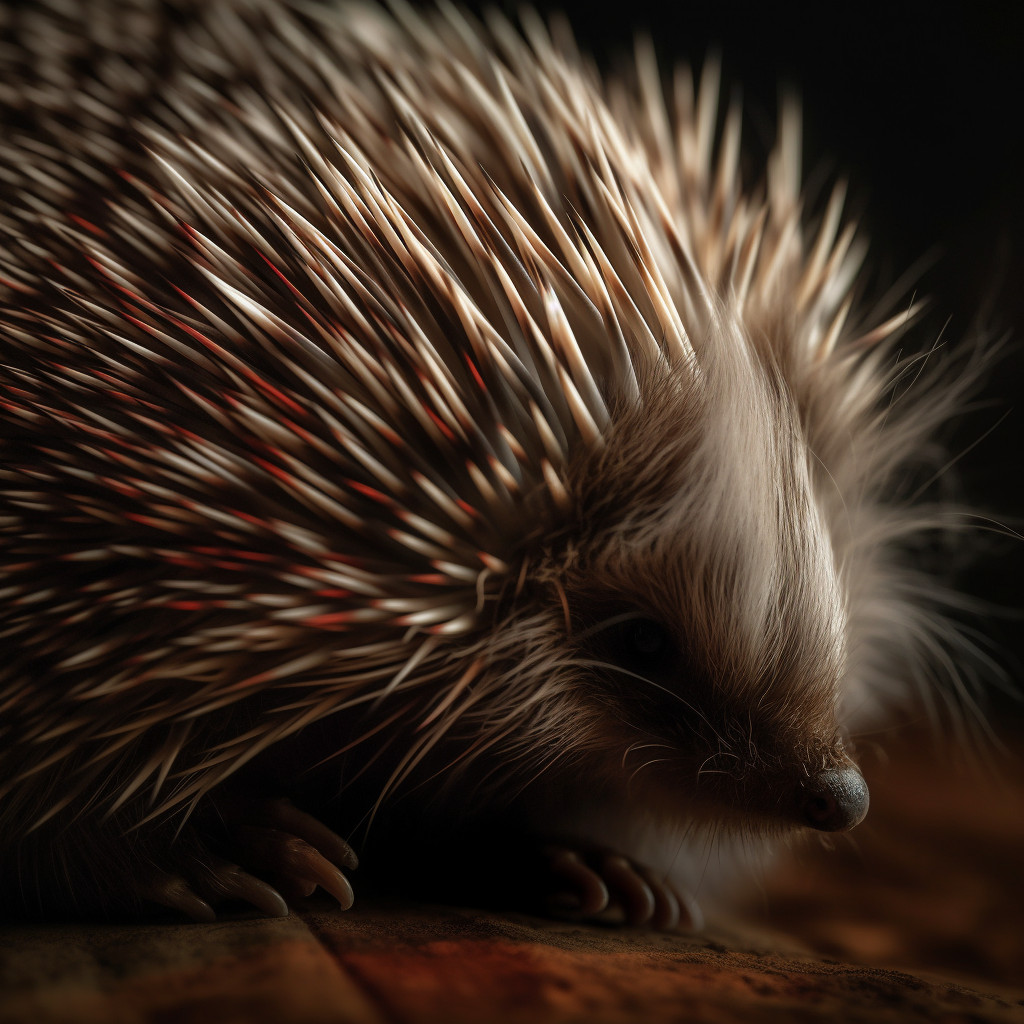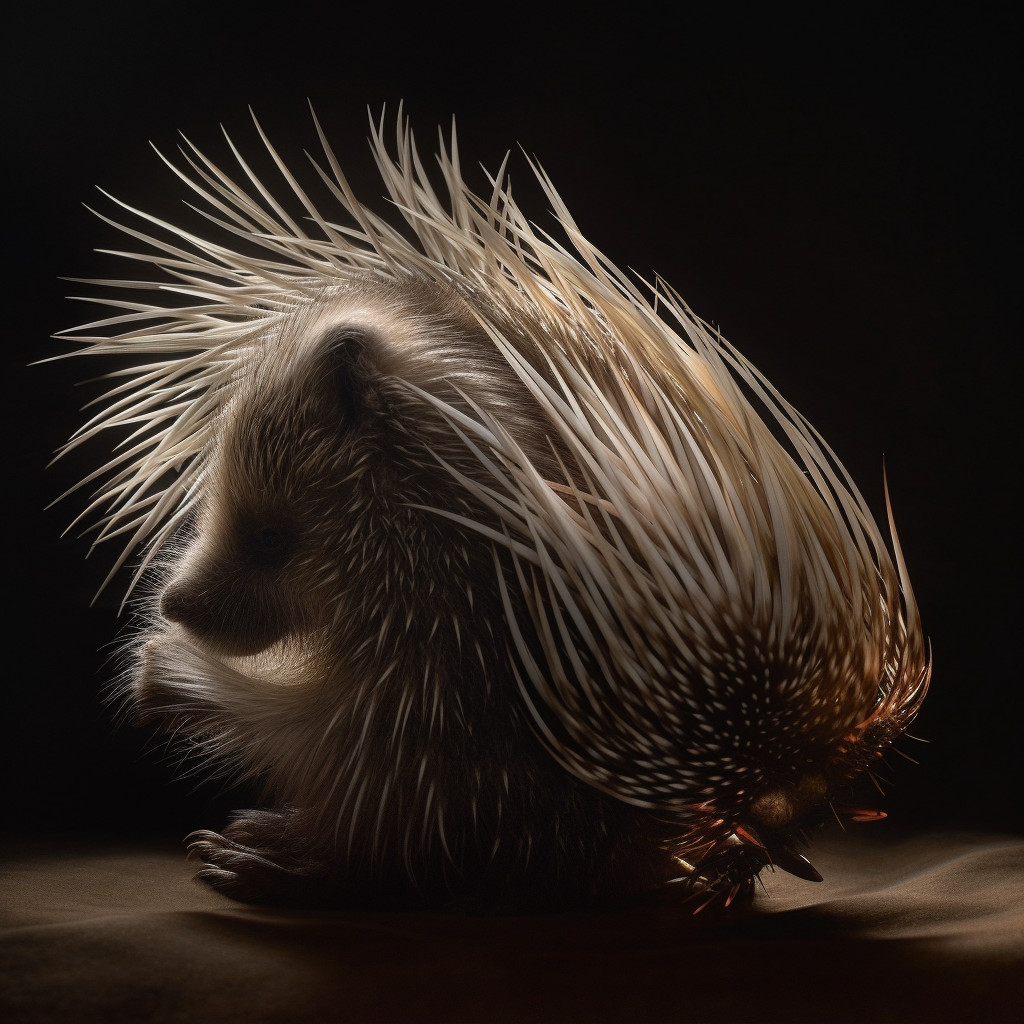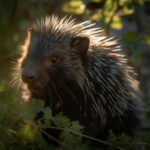Porcupines are fascinating creatures known for their unique defense mechanism – quills. These sharp, needle-like structures cover their bodies, serving as a formidable deterrent to potential predators. But have you ever wondered if porcupines shed their quills? In this article, we will explore the intriguing world of porcupine quills and delve into the question of whether these spiky appendages are shed or not. So, let’s embark on this journey and unravel the mysteries of porcupine quills together.
Key Takeaways
- Porcupines do shed quills as part of their natural growth process.
- Shedding quills helps porcupines maintain their defense mechanism and replace damaged or old quills.
- Shed quills can be found in the porcupine’s habitat and serve as a valuable resource for various purposes.
Understanding Porcupine Quills

Porcupines are fascinating creatures known for their unique defense mechanism – quills. These sharp, needle-like structures play a crucial role in protecting porcupines from predators. In this section, we will explore what porcupine quills are, why porcupines have them, how long they can grow, and where they are located on the porcupine’s body.
A. What are Porcupine Quills?
Porcupine quills are specialized hairs that cover the porcupine’s body. Unlike regular hair, these quills are modified with a sharp, barbed tip, making them an effective defense tool. The quills are made of keratin, the same material found in our hair and nails. However, porcupine quills are much harder and stiffer than regular hair.
B. Why Do Porcupines Have Quills?
Porcupines have quills as a defense mechanism. When threatened by a predator, a porcupine can swing its tail, causing the quills to detach and stick into the predator’s skin. This defense mechanism is highly effective, as the barbs on the quills make them difficult to remove. Predators that get too close to a porcupine may even get quills stuck in their face or paws.
C. How Long Can Porcupine Quills Grow?
Porcupine quills can grow up to several inches in length. The exact length varies depending on the species of porcupine. North American porcupines, for example, have quills that can reach up to 3.7 inches (9.5 cm) long. The length of the quills is essential for their defense strategy. Longer quills increase the chances of a predator suffering more damage when attempting to attack a porcupine.
D. Where are Porcupine Quills Located?
Porcupine quills are primarily located on the back, sides, and tail of the porcupine. These areas have a higher concentration of quills, providing maximum protection. The quills on the tail are especially noteworthy, as they are longer and more easily accessible for the porcupine to swing at a predator. However, it’s important to note that not all parts of a porcupine’s body are covered in quills. The belly, for example, has softer fur and lacks quills.
In summary, porcupine quills are specialized hairs that serve as a defense mechanism. They are made of keratin and have a sharp, barbed tip. Porcupines use their quills to protect themselves from predators by swinging their tails and causing the quills to stick into the predator’s skin. Quills can grow up to several inches in length and are primarily located on the back, sides, and tail of the porcupine. Understanding these fascinating adaptations helps us appreciate the unique biology and behavior of these incredible creatures.
The Life Cycle of Porcupine Quills
Porcupines are fascinating creatures known for their unique defense mechanism – their quills. These sharp, barbed spikes serve as a formidable deterrent to predators, but have you ever wondered how porcupines grow and shed their quills? In this section, we will explore the life cycle of porcupine quills, from their growth to shedding patterns.
A. How Do Porcupines Grow Their Quills?
Porcupines are born with a soft coat of hair, but their quills start to develop shortly after birth. Quills are actually modified hairs made of keratin, the same material found in our own hair and nails. As the porcupine grows, so do its quills. The quills emerge from specialized hair follicles embedded in the porcupine’s skin.
Interestingly, porcupines have different types of quills. The longer, thicker quills are found on their back and tail, while shorter quills cover the rest of their body. These quills serve different purposes – the longer ones act as a primary defense mechanism, while the shorter ones provide additional protection.
B. When Do Porcupines Shed Their Quills?
Porcupines do shed their quills, but the shedding process is not as simple as it may seem. Unlike other animals that shed their fur or feathers, porcupines do not shed their quills all at once. Instead, they shed them individually or in small groups throughout their lifetime.
Quill shedding is a natural process that occurs as new quills grow to replace the old ones. As the porcupine’s body produces new quills, the old ones become loose and eventually fall out. This shedding process helps to keep the porcupine’s quill supply fresh and effective.
C. How Often Do Porcupines Shed Their Quills?
The frequency of quill shedding varies among porcupines. Some porcupines shed their quills more frequently than others, depending on factors such as age, health, and environmental conditions. On average, porcupines shed a few quills every few months.
It’s important to note that quill shedding is not a painful process for porcupines. The quills are firmly embedded in their skin, but they are not attached to any nerves or blood vessels. As a result, shedding quills does not cause any discomfort or harm to the porcupine.
D. Do Porcupines Lose Their Quills in Winter?
Contrary to popular belief, porcupines do not lose all their quills during the winter months. While some animals shed their fur to adapt to seasonal changes, porcupines retain their quills year-round. This is because their quills play a crucial role in their defense against predators, and losing them would leave them vulnerable.
However, it’s worth noting that porcupines may shed a few quills during the winter, just like they do throughout the year. This shedding process helps to maintain the health and functionality of their quills, ensuring they remain effective in deterring potential threats.
In conclusion, porcupines have a fascinating life cycle when it comes to their quills. From the growth of new quills to the shedding of old ones, these unique defense mechanisms are an integral part of a porcupine’s biology. Understanding the life cycle of porcupine quills provides insight into the remarkable adaptations and behaviors of these intriguing creatures.
The Mechanism of Quill Shedding and Release

A. How Do Porcupines Lose Their Quills?
Porcupines are fascinating creatures known for their unique defense mechanism – quill shedding. But how exactly do porcupines lose their quills? Let’s delve into the intriguing process.
Porcupines do not actively shed their quills like humans shed hair. Instead, quill loss occurs as a natural part of their life cycle. Just like human hair, porcupine quills grow continuously throughout their lives. As new quills develop, the old ones are pushed out and eventually fall off.
B. How Do Porcupines Release Their Quills?
When it comes to releasing their quills, porcupines have a remarkable ability. Unlike the common misconception that porcupines can shoot their quills at predators, they actually have a more passive method of defense.
When a porcupine feels threatened, it will often display warning signs such as vocalizations, raising its quills, and even stomping its feet. If the predator fails to heed these warnings and persists in its attack, the porcupine will take defensive action.
Rather than actively shooting their quills, porcupines rely on their unique quill structure for defense. Each quill is covered in tiny barbs that make it difficult to remove once embedded in an attacker. When a predator makes contact with the porcupine, the quills become dislodged from the porcupine’s skin and stick into the predator’s flesh.
C. Why Do Porcupines Lose Their Quills?
Porcupines lose their quills as a means of self-defense. The quills serve as a deterrent to potential predators, providing the porcupine with a formidable defense mechanism. When a predator comes into contact with the porcupine’s quills, they can become embedded in the predator’s skin, causing pain and discomfort.
The quills are not only sharp but also have a hard, keratinous structure, making them difficult to remove. This ensures that the predator will think twice before attempting another attack on a porcupine. The quills can even penetrate the predator’s flesh and reach vital organs, posing a significant risk of infection or injury.
It’s important to note that porcupines do not shed their quills at will. Quill loss occurs as a result of natural wear and tear, and the porcupine’s body automatically replaces the lost quills. This continuous cycle of quill growth and shedding ensures that the porcupine always has a fresh supply of defensive spikes.
In conclusion, porcupines lose their quills as part of their natural life cycle. While they do not actively shed their quills, the old ones are pushed out as new quills grow. When threatened, porcupines rely on their quill structure to defend themselves, embedding the quills into the predator’s flesh. This unique defense mechanism serves as a powerful deterrent and ensures the porcupine’s survival in the wild.
Porcupines and Their Quills: Common Misconceptions
A. Are Porcupines Always Covered in Quills?
When we think of porcupines, one of the first things that comes to mind is their iconic quills. These sharp, needle-like structures are indeed a defining feature of these fascinating creatures. However, contrary to popular belief, porcupines are not always covered in quills.
Porcupines have quills on various parts of their bodies, including their backs, sides, and tails. These quills serve as a defense mechanism, deterring predators from attacking. But it’s important to note that porcupines do not have quills covering their entire bodies. Instead, they have a combination of quill-covered areas and areas with soft fur.
B. Do Porcupines Always Have Quills?
While porcupines do possess quills, it’s important to understand that quills are not a permanent fixture on their bodies. Porcupines do shed quills regularly, and new ones grow in their place. This shedding and regrowth of quills is a natural process for these animals.
Quill shedding is a gradual process, and it occurs throughout the year rather than during a specific season. As old quills become worn or damaged, they are shed, making way for new ones to grow. This ensures that the porcupine always has a fresh supply of sharp quills for protection.
C. Do Pet Porcupines Have Quills?
Porcupines may seem like unusual pets, but some people do keep them in captivity. However, it’s important to note that pet porcupines still have quills. These quills are an inherent part of their biology and cannot be removed or prevented from growing.
If you’re considering keeping a pet porcupine, it’s crucial to understand the care and handling required. Porcupines are not domesticated animals and have specific needs that must be met. Additionally, their quills can pose a risk if not handled properly. It’s essential to seek professional guidance and advice when it comes to caring for pet porcupines.
In conclusion, while porcupines are known for their quills, they are not always covered in them. Quills serve as a defense mechanism for these fascinating creatures, and they shed and regrow them regularly. Whether in the wild or as pets, porcupines will always have their quills as a unique and important part of their biology.
The Significance of Porcupine Quills

Porcupines are fascinating creatures known for their unique defense mechanism – their quills. These sharp, needle-like structures play a crucial role in the survival of porcupines in the wild. In this section, we will explore the significance of porcupine quills, including their potential value and their importance in porcupine’s defense against predators.
A. Can You Sell Porcupine Quills?
Porcupine quills have been historically used by various cultures for a variety of purposes. In some regions, these quills hold cultural significance and are used in traditional crafts, such as jewelry, clothing embellishments, and decorative items. The quills’ natural beauty and unique texture make them desirable for artistic creations.
However, it is important to note that the sale of porcupine quills may be regulated in certain areas due to conservation concerns. Before considering selling or purchasing porcupine quills, it is essential to research and understand the legalities surrounding their trade in your specific location.
B. The Role of Quills in Porcupine Survival
Porcupine quills are not just ornamental; they serve as a formidable defense mechanism against predators. When threatened, a porcupine will raise its quills, making itself appear larger and more intimidating. This display is often enough to deter predators from attacking.
If a predator persists, the porcupine will take a defensive stance, swinging its tail towards the attacker. The quills on the tail are loosely attached and can easily detach upon contact, embedding themselves into the predator’s skin. These quills are designed with barbs and are stiff, making them difficult to remove. This defense mechanism ensures that the predator suffers the consequences of its actions.
Porcupine quills are made of keratin, the same material found in human hair and nails. They are incredibly hard and have a small, sharp tip, making them effective weapons. The quills also have a protective covering, which prevents them from injuring the porcupine itself.
Interestingly, porcupines have quills all over their bodies, not just on their tails. Their quills act as a warning sign to potential predators, indicating that they are not to be messed with. Even a slight touch can result in painful consequences for the predator.
In the event that a porcupine loses some of its quills during an encounter, it has the remarkable ability to regenerate them. Quill regeneration is a slow process, but it ensures that the porcupine is always well-equipped to defend itself.
It is worth noting that if a human or any other animal gets quills embedded in their skin, it is crucial to seek medical attention. Removing quills without professional assistance can be risky, as they may be deeply embedded and could potentially reach vital organs. Additionally, the risk of infection or broken quills must be considered.
In conclusion, porcupine quills are not only visually striking but also serve as a vital defense mechanism for these unique creatures. Their ability to deter predators and inflict pain upon attackers ensures the porcupine’s survival in the wild. While the sale of porcupine quills may be regulated, their cultural significance and practical uses make them intriguing objects of interest. Conclusion
In conclusion, porcupines do shed their quills as a natural part of their growth and maintenance process. These quills, which are modified hairs, serve as a defense mechanism for porcupines, deterring potential predators. Shedding quills allows porcupines to replace damaged or old quills with new ones, ensuring their protection remains intact. While the shedding process may vary among porcupine species, it typically occurs throughout the year rather than in a specific season. Shed quills can often be found in the vicinity of porcupine habitats, serving as a reminder of the unique adaptations of these fascinating creatures. So, the next time you come across a porcupine quill, you’ll know that it’s a result of their natural shedding process.
Frequently Asked Questions
Do porcupines lose their quills?
Yes, porcupines do lose their quills. This is a natural process and is part of their defense mechanism. When a predator approaches, a porcupine can release its quills to protect itself.
Are porcupines covered in quills?
Yes, porcupines are covered in quills. These quills serve as a defense mechanism against predators. The quills are sharp, stiff hairs that can cause significant discomfort to any animal that comes into contact with them.
How do porcupines lose their quills?
Porcupines lose their quills as part of their natural behavior. When threatened, they can release their quills to ward off predators. The lost quills are then replaced through a process of quill regeneration.
How often do porcupines shed their quills?
Porcupines shed their quills throughout their lifetime. The frequency of quill shedding varies, but it typically occurs once a year during the quill shedding season.
Why do porcupines have quills?
Porcupines have quills as a defense mechanism. The quills are sharp and can easily embed themselves in the skin of a potential predator, causing pain and discouraging the predator from attacking.
How long can porcupine quills grow?
Porcupine quills can grow up to 30 centimeters in length, depending on the species. The North American porcupine, for example, has quills that are typically between 5 and 7 centimeters long.
Do porcupines always have quills?
Yes, porcupines always have quills. Even when they shed or lose their quills, the process of quill regeneration ensures that new quills grow back to replace the lost ones.
Do pet porcupines have quills?
Yes, pet porcupines also have quills. It’s important to remember that these quills can be dangerous and can cause injury if not handled properly.
When do porcupines shed their quills?
Porcupines typically shed their quills once a year during the quill shedding season. However, the exact timing can vary depending on the individual porcupine’s age, health, and species.
Can you sell porcupine quills?
Yes, it is possible to sell porcupine quills. They are often used in traditional crafts and artwork. However, it’s important to ensure that the quills are sourced ethically and in accordance with local wildlife laws.



